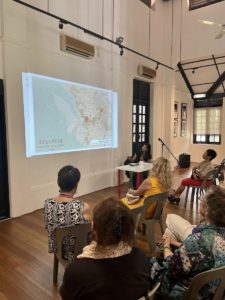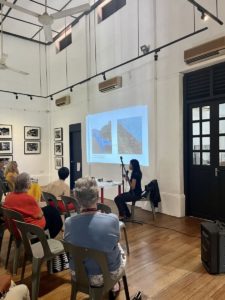

If you are interested in the history and culture of Malaysia, like me, the lecture presented by Mariana Isa “Kota Raja Mahadi “, which took place on 01.11.2023 hit the target exactly, which aroused a desire to learn more. This young lady is a director heritage lab in a private research organization and has participated in a 1-month restoration project in the fort as a site supervisor. The story of Raja Mahadi Fort is a story of wars, rivalries, betrayals, struggle for power and influence.
The Fort is situated on Bukit Kota in Klang not far from the river and was built by Raja Mahadi in 1866 as a place of defense during the two Selangor Civil Wars. In those days, the only transport between Klang and Kuala Lumpur was by river and the location of the fort on the highest point in Klang gave a good opportunity to observe all passing ships and boats, especially those to his enemy Gadong (warehouse) Raja Abdullah.
The war started because of Raja Mahadi’s jealousy of Raja Abdullah, appointed as the Governor of Selangor, a very successful and wealthy businessman. Raja Mahadi was angry as he considered himself the heir apparent to the post by right, being the son of the previous ruler of these lands. He was also incited by a man named Mohamad Akib, a leader of Sumatran immigrants (Batu Bara clan), who was unhappy as Raja Abdullah (Bugis Malay) refused to punish the murderer of one of his men. Mohamad Akib was shot and killed however in 1867 and his grave remains at the Fort to this day.
The first stage of the war ended with the victory of Raja Mahadi after a failed attack by Raja Abdullah and his sons using three river steamers. Raja Mahadi becomes the ruler of Klang (1867-1870).
In the second stage, the Prince of Kedah, Tunku Kudin, intervenes, tries to mediate between the parties, but after the failure of his mission, he attacked the fort by land and river. After a few months of siege, one of the attacks was successful. Raja Mahadi retreated as he ran out of food supply and Tunku Kudin took over the Fort as his headquarters. At that time, according to eyewitnesses, the Fort was well equipped with guns of various sizes.
As a result of the chaos caused by the wars, trade, and the lives of the people lost, the region suffered. Therefore in 1875, Sultan Abdul Samad requested that Selangor become a British protectorate.
Nowadays, due to the relentless impact of time, only a small part of the fort – the front entrance and the arch-way entrance – was preserved. At the front entrance can be seen Dutch standard sized bricks from the construction. Many of the historical artifacts were buried because of the changes of that timе.
During Maryana Isa’s one month-long project, the lower steps of the main entrance were restored together with the partial walls around them.
The event we attended was held at the Heritage place of Badan Warisan Malaysia, which further contributed to get a better feel of the spirit of this bygone time.
The lecture was very interactive with group members asking the lecturer questions and all were answered.
Throughout the presentation, there was a sense of empathy and dedication to Malaysia’s cultural and historical heritage, despite the regret that the fort has not been sufficiently well conserved and preserved for next generations.
After this lecture, I think our audience got a better understanding of the historical events that preceded the colonial period in Selangor.
Daniela Beloreshka
